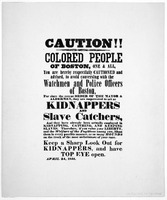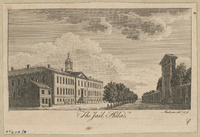The Carceral State: Legal Histories of American Unfreedom
Item set
Items
-
 13th Amendment to the United States Constitution (1865)
13th Amendment to the United States Constitution (1865) The Thirteenth Amendment abolished slavery in the United States except for as punishment for a crime. This exception has become a source of debate and controversy regarding the escalation of incarceration rates and the exploitation of incarcerated people for the benefit of corporate profits. The amendment was passed by Congress January 31, 1865, and ratified December 6, 1865.
-
 Broadside Reacting to the Fugitive Slave Act (1851)
Broadside Reacting to the Fugitive Slave Act (1851) This broadside was distributed in Boston following the passage of the Fugitive Slave Act of 1850.
-
 California Proposition 6 (2024)
California Proposition 6 (2024) A proposed amendment to the California that would have banned involuntary servitude as a punishment for a crime. This measure failed in the 2024 election, meaning the State of California remains one of 16 states that still allows forced labor. A similar ballot measure also failed in 2022.
-
 Chain Gang Blues (1925)
Chain Gang Blues (1925) Chain Gang Blues was a song recorded by blues singer Ma Rainey in 1925 that reflects the experience of Black Americans in the Jim Crow South. In the song, the protagonist has been sent on the chain gang for reasons that she thinks are unjust.
-
 Fugitive Slave Act of 1850
Fugitive Slave Act of 1850 The Fugitive Slave Act of 1850 was a part of the Compromise of 1850. The act addressed weaknesses in previous fugitive slave acts by penalizing officials who did not aid in returning escaped slaves. The Fugitive Slave Act of 1850 rendered Habeas Corpus irrelevant.
-
 Terry v. Ohio (1968)
Terry v. Ohio (1968) Terry v. Ohio is the landmark Supreme Court case that established the basis for stop and frisk policies. These policies disproportionately affect Black people and lead to the disproportionate incarceration of Black Americans.
-
 The Carceral State: Legal Histories of American Unfreedom
The Carceral State: Legal Histories of American Unfreedom This teaching module discusses race, the carceral state, and the criminalization of Blackness, featuring a webinar with legal historian Taja-Nia Henderson.
-
 Walnut Street Prison (1789)
Walnut Street Prison (1789) An etching of the Walnut Street Prison in Philadelphia. Established as a city jail in 1773, it was expanded in 1790 to become the first state penitentiary in the new country. This prison was among the first to feature individual cells and was built to accommodate work details. The penitentiary was noted to have a larger percentage of Black inmates than white, noting the racialization of incarceration in the United States. The prison was in operation until 1838.
-
 Webinar - The Carceral State: Legal Histories of American Unfreedom (2024)
Webinar - The Carceral State: Legal Histories of American Unfreedom (2024) In this webinar, Professor Taja-Nia Henderson of Rutgers Law School discusses race, the carceral state, and the criminalization of Blackness with Professor Danielle Jefferis of the University of Nebraska College of Law and our And Justice For All class.
 13th Amendment to the United States Constitution (1865) The Thirteenth Amendment abolished slavery in the United States except for as punishment for a crime. This exception has become a source of debate and controversy regarding the escalation of incarceration rates and the exploitation of incarcerated people for the benefit of corporate profits. The amendment was passed by Congress January 31, 1865, and ratified December 6, 1865.
13th Amendment to the United States Constitution (1865) The Thirteenth Amendment abolished slavery in the United States except for as punishment for a crime. This exception has become a source of debate and controversy regarding the escalation of incarceration rates and the exploitation of incarcerated people for the benefit of corporate profits. The amendment was passed by Congress January 31, 1865, and ratified December 6, 1865. Broadside Reacting to the Fugitive Slave Act (1851) This broadside was distributed in Boston following the passage of the Fugitive Slave Act of 1850.
Broadside Reacting to the Fugitive Slave Act (1851) This broadside was distributed in Boston following the passage of the Fugitive Slave Act of 1850. California Proposition 6 (2024) A proposed amendment to the California that would have banned involuntary servitude as a punishment for a crime. This measure failed in the 2024 election, meaning the State of California remains one of 16 states that still allows forced labor. A similar ballot measure also failed in 2022.
California Proposition 6 (2024) A proposed amendment to the California that would have banned involuntary servitude as a punishment for a crime. This measure failed in the 2024 election, meaning the State of California remains one of 16 states that still allows forced labor. A similar ballot measure also failed in 2022. Chain Gang Blues (1925) Chain Gang Blues was a song recorded by blues singer Ma Rainey in 1925 that reflects the experience of Black Americans in the Jim Crow South. In the song, the protagonist has been sent on the chain gang for reasons that she thinks are unjust.
Chain Gang Blues (1925) Chain Gang Blues was a song recorded by blues singer Ma Rainey in 1925 that reflects the experience of Black Americans in the Jim Crow South. In the song, the protagonist has been sent on the chain gang for reasons that she thinks are unjust. Fugitive Slave Act of 1850 The Fugitive Slave Act of 1850 was a part of the Compromise of 1850. The act addressed weaknesses in previous fugitive slave acts by penalizing officials who did not aid in returning escaped slaves. The Fugitive Slave Act of 1850 rendered Habeas Corpus irrelevant.
Fugitive Slave Act of 1850 The Fugitive Slave Act of 1850 was a part of the Compromise of 1850. The act addressed weaknesses in previous fugitive slave acts by penalizing officials who did not aid in returning escaped slaves. The Fugitive Slave Act of 1850 rendered Habeas Corpus irrelevant. Terry v. Ohio (1968) Terry v. Ohio is the landmark Supreme Court case that established the basis for stop and frisk policies. These policies disproportionately affect Black people and lead to the disproportionate incarceration of Black Americans.
Terry v. Ohio (1968) Terry v. Ohio is the landmark Supreme Court case that established the basis for stop and frisk policies. These policies disproportionately affect Black people and lead to the disproportionate incarceration of Black Americans. The Carceral State: Legal Histories of American Unfreedom This teaching module discusses race, the carceral state, and the criminalization of Blackness, featuring a webinar with legal historian Taja-Nia Henderson.
The Carceral State: Legal Histories of American Unfreedom This teaching module discusses race, the carceral state, and the criminalization of Blackness, featuring a webinar with legal historian Taja-Nia Henderson. Walnut Street Prison (1789) An etching of the Walnut Street Prison in Philadelphia. Established as a city jail in 1773, it was expanded in 1790 to become the first state penitentiary in the new country. This prison was among the first to feature individual cells and was built to accommodate work details. The penitentiary was noted to have a larger percentage of Black inmates than white, noting the racialization of incarceration in the United States. The prison was in operation until 1838.
Walnut Street Prison (1789) An etching of the Walnut Street Prison in Philadelphia. Established as a city jail in 1773, it was expanded in 1790 to become the first state penitentiary in the new country. This prison was among the first to feature individual cells and was built to accommodate work details. The penitentiary was noted to have a larger percentage of Black inmates than white, noting the racialization of incarceration in the United States. The prison was in operation until 1838. Webinar - The Carceral State: Legal Histories of American Unfreedom (2024) In this webinar, Professor Taja-Nia Henderson of Rutgers Law School discusses race, the carceral state, and the criminalization of Blackness with Professor Danielle Jefferis of the University of Nebraska College of Law and our And Justice For All class.
Webinar - The Carceral State: Legal Histories of American Unfreedom (2024) In this webinar, Professor Taja-Nia Henderson of Rutgers Law School discusses race, the carceral state, and the criminalization of Blackness with Professor Danielle Jefferis of the University of Nebraska College of Law and our And Justice For All class.